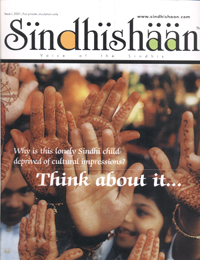MISSION POSSIBLE – Persevering to preserve
SITA SINDHU BHAVAN – SPIRIT OF REVIVAL
By Sreekanth R
At a time when the Sindhi culture seems to be fast disappearing into oblivion, hope beams in the form of these institutions that are relentlessly working towards reviving its lost glory . . . . .
On a lazy Sunday morning, the by-lance of this suburban locale in Mumbai is suddenly flooded with an influx of elderly people. The swarm of humanity is gradually seen moving towards a white building, and minutes later, a soothing melody reverberates across the streets. The lilting tune and the impeccable lyrics are reminiscent of an ancient Sindhi prayer that was a ritual in primeval Sindh. The edifice from where the melodious tune emanates is Sita Sindhu Bhavan, the structure that has in fact given shape to Prof. Ram Panjwani’s dream to put the Sindhis on the cultural map.
Sita Sindhu Bhavan is a temple, an art exhibition centre and a dissemination centre for folk art all harboured under one roof. Created in an effort to weld together the Sindhi community and nurture facets of its culture, this centre today attracts hoards of Sindhis who have a genuine interest in the well being of their community. Every second Sunday of the month, these Sindhis congregate over here to witness the revival of the Sindhi culture, with performances by various artists from across the country. “The most remarkable aspect of this centre is the attendance of Sindhis for every fortnightly function who make it to the performances without any invitation,” says Thakur Chawla, the elderly gentleman who has been instrumental in the centres development. Seated besides the makeshift stage, Shri Chawla looks intently at the proceedings keeping a watchful eye on the guests. “All of them are regular visitors,” he says. “Most of them have been coming here for years.” It is indeed the enthusiastic participation of these veterans that has helped the centre gain its place of importance on the Sindhi cultural map. “Keeping the culture alive is the key objective of the centre,” says Shri Chawla in an unassuming tone that is self-effacing of the quintessential task he has undertaken on behalf of the centre.
When asked about the arduous task of arranging performers for shows every fortnight, Shri Chawla retorts, “It is not as difficult as it seems. We get requests from performers across the country expressing their desire to perform here. All the shows for the next six months have already been booked.” Sita Sindhu Bhavan has lent many aspiring artists with an opportunity to display their skills and the centre has taken care to appreciate the artists for their exemplary effort in keeping the culture alive. And the funds required for sustaining the foundation come from benevolent beneficiaries across the globe. “The institution is flooded with funds from people in the Middle East, South-East Asia and the likes,” says Shri Chawla.
But perhaps the most important activity of the centre is the provision of residential facilities for all those who are interested in the research of Sindhi art and culture. The centre hosts an art gallery in its basement, exhibiting paintings and photographs reminiscent of the past of Sindh. The foundation also allows foreign students to come in and research on the Sindhi culture.
“Ever since this centre has started it has effervescently spread a spirit of cultural revival,” says Shri Chawla, as he announces on stage the felicitation of one of the leading journalist who has wielded the pen potently to disseminate the culture. A good cause shall never face any paucity of funds. Housing the resurrection of a lost culture, this foundation presents a remarkable proof.


